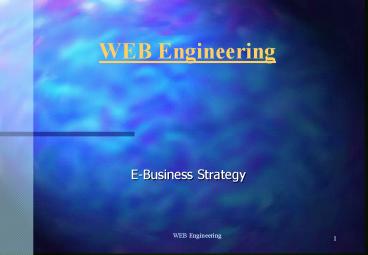WEB Engineering - PowerPoint PPT Presentation
1 / 13
Title:
WEB Engineering
Description:
Formulating/Analysing Web-Based Systems. Design for Web-Based Applications ... Use an analysis tool, such as Bobby', to examine your pages ... – PowerPoint PPT presentation
Number of Views:265
Avg rating:3.0/5.0
Title: WEB Engineering
1
WEB Engineering
- E-Business Strategy
WEB Engineering
1
2
Contents
- The Attributes of Web-Based Applications
- The Web Eng. Process
- A Framework for Web Eng.
- Formulating/Analysing Web-Based Systems
- Design for Web-Based Applications
- Testing Web-Based Applications
- Management Issues
2
3
The Attributes of Web-based Applications
- The Situation - the vast majority of web-based
applications are - network intensive,
- content-driven,
- in continuous evolution.
- Quality Attributes - general quality attributes
apply as much to web-based apps as to other s/w
product. The difference is in emphasis on
Usability, Functionality, Reliability,
Maintainability - The Technologies - development of web apps uses
- component-based development /software
engineering, - security paradigms - methods, tools, procedures,
- Internet standards (HTML, XML, de facto media
standards, etc.).
3
4
Process
- The Web Eng. Process is shaped by
- Networks,
- Content
- as much a material and design issue as a
functional issue - Continuous evolution
5
A Framework for Web Engineering.
- Remembering the continuously evolving nature of
web apps, a spiral model - formulation,
- planning,
- analysis,
- engineering,
- page generation and testing,
- customer evaluation
- engineering architectural / navigation /
interface design - content design / production
6
Formulation, Planning and Analysis
- Formulation - ask the questions to identify the
objectives and audience of the web app. - Planning - costs, resources, risks, plans,
timescale (always compressed!). - Analysis - content, interaction, functional,
confign. - (cf. requirements analysis)
7
Engineering/Design
- Stages
- Architecture (structures),
- Architecture (patterns),
- Navigation,
- Interface,
- Production.
- (refer to checklist, etc. at back of presentation)
8
Testing Web Apps
- Review content
- Review design
- Processing components are unit tested
- Architecture integration tests
- Complete Web app tested (functionality content
delivery) - Environment (operating systems) compatibility
testing - End-user tests
9
Management
- The Web team - different people for different
roles - Project management -
- outsourcing issues
- estimation - time, schedule, resources, etc.
- risk estimation
- Scope
- Configuration Management -
- content control
- people / authority to make, approve, implement
changes - scale (change to scale change to type of
control) - ownership of components (rights and
responsibilities)
10
Enterprise Usability Management A Compass for
Top Management
- Equate usability with competitiveness and quality
in the enterprise - Trace cost of usability problems to the source
- Incorporate design and evaluation cycles into
product development - Balance the use of static design standards and
dynamic research results - Systematise the learning of design principles and
skills - Develop team evaluation methods for team design
projects. - Align feedback loops from all sources toward new
product design - Maintain cross-project collaboration in the
product design process - Align all forms of communication to customers who
use the products - Participate in growing the base of knowledge
about usability - .
11
Ten Steps to Product Usability A Roadmap for
Project Managers
- Set strategic and detailed usability objectives
- Develop and incorporate user profiles
- Prioritise critical product components and task
flow - Identify a design team and clarify roles
- Define the UI design process (traditional GUI and
Web interfaces) - Develop a usability evaluation strategy
- a usability test plan.... when should you test?
how should you structure the test? - Establish product design guidelines (traditional
GUI and Web designs) - Develop a UI specifications documentation
procedure - Develop a user assistance strategy
- help, tutorials, splash screens, etc. that
make-up the user assistance strategy - Maintain a feedback channel for users
12
Ten Elements of Usability A Yardstick for
Designers
- Clarify the core concepts of the design
- Plan and maintain consistency (internal and
external consistency of UI design) - Fit content to customers who use the product
- Provide reassuring and effective feedback
- Clarify interaction rules (dialog design, data
entry, selection, modes, drag and drop, etc.) - Structure navigation clearly (menus, tree
structures) - Use plain terminology (terminology within the
user's knowledge domain - know your user) - Optimise user assistance (help tools /on-line
help and documentation) - Optimise visual design (graphics, layout, icons,
metaphors, real world models) - Design for the context of use
13
Checklist for Testing Your Web Pages for
Accessibility
- Turn off graphics, make sure the ALT text
displayed makes the page usable - Turn off sounds, make sure no important
instructions are lost - Turn off style sheets, to make sure the page is
still readable - Use the High Contrast option in the Accessibility
Options section of Control Panel, restart the
browser, make sure the page is still readable. - Use Custom Font Sizes in the Display section of
Control Panel - Use the largest font size supported by the
browser (the largest is only available when High
Contrast mode is turned on) - Resize the browser window larger and smaller
- Navigate using the keyboard, make sure TAB
traverses all links in reasonable order and that
CTRLTAB moves between panes or sections - Select all text and copy it to the clipboard,
ensure it makes sense when pasted into a word
processor - Use an analysis tool, such as Bobby, to examine
your pages































